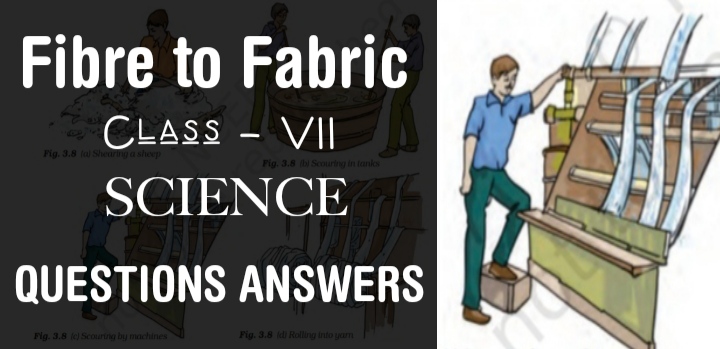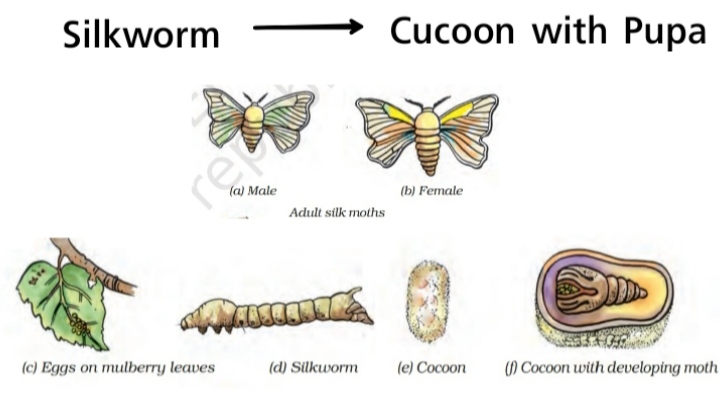Fibre to Fabric class 7 Science NCERT Solutions
Fibre to Fabric class 7 Science NCERT Solutions: Fibre to Fabric is the chapter 3 from class 7 Science NCERT. Here you'll get Fibre to Fabric class 7 Science/Fibre to Fabric class 7 Science NCERT Solutions.
Fibre to Fabric class 7 Science Main Points/Notes
Silk comes from silkworms and wool is obtained from sheep, goat and yak. Hence silk and wool are animal fibres. The hairs of camel, llama and alpaca are also processed to yield wool.
In India, mostly sheep are reared for getting wool. Sheep hair is sheared off from the body, scoured, sorted, dried, dyed, spun and woven to yield wool.
Silkworms are caterpillars of silk moth. During their life cycle, the worms spin cocoons of silk fibres. Silk fibres are made of a protein. Silk fibres from cocoons are separated out and reeled into silk threads. Weavers weave silk threads into silk cloth.
The exact time of discovery of silk is perhaps unknown. According to an old Chinese legend, the empress Si-lung-Chi was asked by the emperor Huang-ti to find the cause of the damaged leaves of mulberry trees growing in their garden.
The empress found white worms eating up mulberry leaves. She also noticed that they were spinning shiny cocoons around them. Accidentally a cocoon dropped into her cup of tea and a tangle of delicate threads separated from the cocoon.
Silk industry began in China and was kept a closely guarded secret for hundreds of years. Later on, traders and travellers introduced silk to other countries.
Class 7 Science Chapter 3 Fibre to Fabric Questions Answers
Exercises
1. You must be familiar with the following nursery rhymes:
(i) ‘Baa baa black sheep, have you any wool.’
(ii) ‘Mary had a little lamb, whose fleece was white as snow.’
Answer the following:
(a) Which parts of the black sheep have wool ?
Ans: The hairy skin called fleece has wool in black sheep.
(b) What is meant by the white fleece of the lamb ?
Ans: White fleece of the lamb means the white coloured hairy skin.
2. The silkworm is (a) a caterpillar, (b) a larva. Choose the correct option.
(i) a (ii) b (iii) both a and b (iv) neither a nor b.
Ans: both a and b.
3. Which of the following does not yield wool ?
(i) Yak (ii) Camel (iii) Goat (iv) Woolly dog
Ans: Woolly dog
NCERT Solutions of Fibre to Fabric class 7 Science
4. What is meant by the following terms ?
(i) Rearing (ii) Shearing (iii) Sericulture
Ans:
(i) Rearing: The process of keeping, feeding, breeding and medical care of useful animals is called rearing of animals. These animals produce one or more useful products for human beings.
(ii) Shearing: The process of removing the fleece of the sheep alongwith thin layer of skin is called shearing.
(iii) Sericulture: The rearing of silkworms for obtaining silk is called sericulture.
5. Given below is a sequence of steps in the processing of wool. Which are the missing steps ? Add them.
Shearing, __________, sorting, __________, __________, _________.
Ans: Shearing, scouring, sorting, picking out of burrs, colouring, rolling.
Class 7 Science Chapter 3 Questions Answers
6. Make sketches of the two stages in the life history of the silk moth which are directly related to the production of silk.
Ans:
7. Out of the following, which are the two terms related to silk production ?
Sericulture, floriculture, moriculture, apiculture and silviculture.
Hints: (i) Silk production involves cultivation of mulberry leaves and
rearing silkworms.
(ii) Scientific name of mulberry is Morus alba.
Ans: (i) Sericulture (ii) Moriculture
8. Match the words of Column I with those given in Column II:
Column I Column II
1. Scouring (a) Yields silk fibres
2. Mulberry leaves (b) Wool yielding animal
3. Yak (c) Food of silk worm
4. Cocoon (d) Reeling
(e) Cleaning sheared skin
Ans: Column I Column II
(i) Scouring (e) Cleaning sheared skin
(ii) Mulberry leaves (c) Food of silk worm
(iii) Yak (b) Wool yielding animal
(iv) Cocoon (a) Yields silk fibres










No comments:
Post a Comment
Kindly donnot paste any SPAM link. Thank you very much for reading, Happy learning.